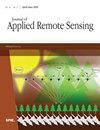基于合成生成对抗网络生成清晰度更高的多光谱卫星图像
IF 1.4
4区 地球科学
Q4 ENVIRONMENTAL SCIENCES
引用次数: 0
摘要
合成多光谱卫星图像的生成尚未达到其他领域的质量水平,例如人脸图像的生成和处理。困难的部分原因是需要在这些图像覆盖的整个电磁波谱范围内生成一致的数据,其辐射分辨率要高于多媒体应用中通常使用的分辨率。与不同波长相对应的图像波段的空间分辨率不同会带来额外的问题,其主要影响是合成图像与原始图像相比缺乏空间细节。我们提出了两种基于生成式对抗网络的架构,通过对 13 波段的哨兵-2 level1-C 图像进行样式转移,生成合成卫星图像。为了避免丢失更精细的空间细节并提高生成图像的清晰度,我们引入了一种类似于平锐化的方法,将输入图像的空间结构转移到样式转移图像中,而不引入可见的伪影。我们应用所提出的架构将贫瘠图像转换为植被图像,反之亦然,并将夏季(res. winter)图像转换为冬季(res. summer)图像,这些结果证实了所提出解决方案的有效性。本文章由计算机程序翻译,如有差异,请以英文原文为准。
Generation of synthetic generative adversarial network-based multispectral satellite images with improved sharpness
The generation of synthetic multispectral satellite images has not yet reached the quality level achievable in other domains, such as the generation and manipulation of face images. Part of the difficulty stems from the need to generate consistent data across the entire electromagnetic spectrum covered by such images at radiometric resolutions higher than those typically used in multimedia applications. The different spatial resolution of image bands corresponding to different wavelengths poses additional problems, whose main effect is a lack of spatial details in the synthetic images with respect to the original ones. We propose two generative adversarial networks-based architectures explicitly thought to generate synthetic satellite imagery by applying style transfer to 13-band Sentinel-2 level1-C images. To avoid losing the finer spatial details and improve the sharpness of the generated images, we introduce a pansharpening-like approach, whereby the spatial structures of the input image are transferred to the style-transferred images without introducing visible artifacts. The results we got by applying the proposed architectures to transform barren images into vegetation images and vice versa and to transform summer (res. winter) images into winter (res. summer) images, which confirm the validity of the proposed solution.
求助全文
通过发布文献求助,成功后即可免费获取论文全文。
去求助
来源期刊

Journal of Applied Remote Sensing
环境科学-成像科学与照相技术
CiteScore
3.40
自引率
11.80%
发文量
194
审稿时长
3 months
期刊介绍:
The Journal of Applied Remote Sensing is a peer-reviewed journal that optimizes the communication of concepts, information, and progress among the remote sensing community.
 求助内容:
求助内容: 应助结果提醒方式:
应助结果提醒方式:


